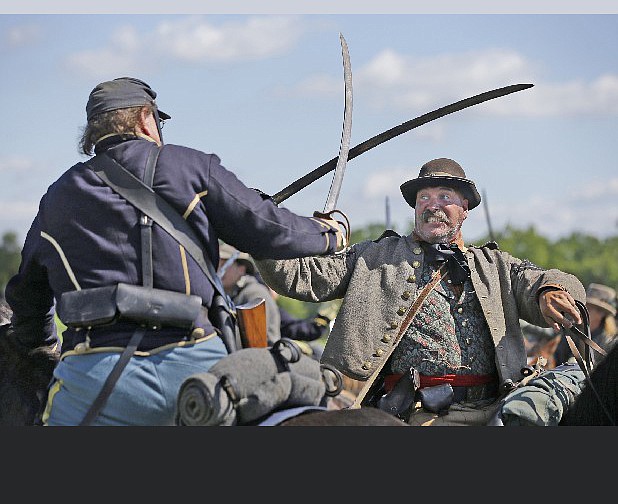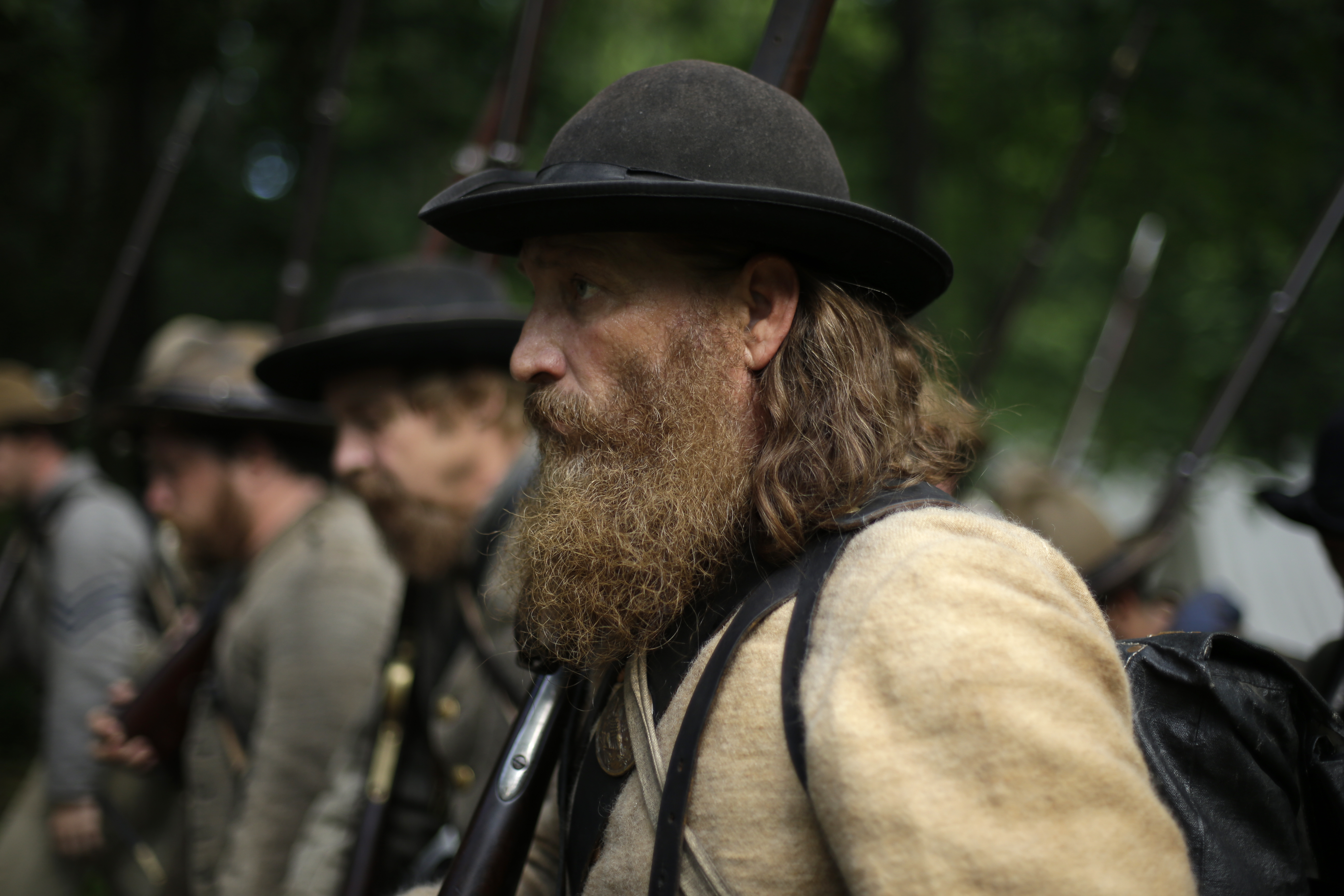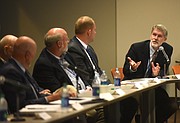Re-enactment opens Gettysburg anniversary events
Sunday, June 30, 2013
VENDORS HOPE TO CASH IN
GETTYSBURG, Pa. - As re-enacted war raged several miles away, tourists strolled a commercial strip of Gettysburg to survey T-shirts, hats and other trinkets to commemorate the 150th anniversary of the Civil War's pivotal battle.More than 200,000 people - including thousands of re-enactors - are expected to visit this small south-central Pennsylvania town through Fourth of July weekend to mark the milestone.And it's a prime opportunity for vendors to make some money.Sightseers can pick up one of the many incarnations of "150th Anniversary" T-shirts at stores along about a two-block stretch of one of the main drags in town, Steinwehr Avenue, less than a quarter-mile from the Gettysburg National Military Park. One store, in between two shops that promote ghost tours, had "Army of the Potomac" and "Army of Northern Virginia" athletic department shirts among offerings hanging on its porch.A few visitors said they aren't comfortable with the consumerism in town."I don't like the commercialism. I think they can do a lot less of it," said Richard Gow, 65, of Binghamton, N.Y. Dressed sharply in a gray uniform, Gow was portraying noted Confederate Gen. Lewis Armistead outside the American Civil War Wax Museum.Then Gow - himself a U.S. Army veteran who served during Vietnam - looked toward the battlefield, just down the road. That is where the self-proclaimed Civil War buff, who said his family ties trace back to Confederate Major Gen. John Gordon, said visitors can find what's really important."It's the grounds," he said reverentially, referring to the fields and hills where up to 10,000 Union and Confederate soldiers died in the Civil War's pivotal conflict. "It's an honor to be here."Federal forces turned away the Confederates during fierce fighting on July 1-3, 1863, ending with the South's ill-fated Pickett's Charge across an open field against Union soldiers.But making money on Gettysburg isn't new. In fact, profiteers went out to scour the battlefield, after the fighting was over, to search for relics to sell, said Peter Carmichael, professor of history at Gettysburg College.Soon after the war, a brothel was established on Little Round Top, the hill that was the sight of key fighting later made famous in the 1974 Pulitzer Prize- winning novel, "The Killer Angels," and the 1993 movie "Gettysburg." That's long gone, too, with the National Park Service overseeing the land now."The battlefield in many ways is much less commercialized than it once was," Carmichael said Saturday.George Lomas, owner of The Regimental Quartermaster store on the busy commercial strip said he's been gearing up for this week for months. His business primarily attracts re-enactors looking to buy period military jackets, shirts and belts along with bayonets and muskets.Smaller tables near the front door carried 150th anniversary T-shirts and more kitschy items like a pen shaped like a mini-drumstick inscribed with "Civil War."Re-enactors have been streaming in this week, Lomas said, but he also sells items for tourists.When asked about people who may think Gettysburg is too commercialized, Lomas said, "That happens. That's business. I don't think it's over-commercialized. Of course, I'm prejudiced."He noted how a stretch of road along the actual battlefield actually became less commercialized. He was referring to the Park Service's efforts in recent years to rehabilitate major areas of the battlefield to make it better resemble the territory soldiers encountered 150 years ago.One of the changes involved removing a motel that that once stood across the street from a monument for Ohio soldiers. The rehabilitation process grew out of a master plan in 1999 that didn't set the 150th anniversary as a deadline - though park officials say it was a welcome and timely coincidence.The Killer Angels, written by Michael Shaara, and the Gettysburg movie have been credited with increasing interest in the war in recent decades. Shaara died in 1988.His son, Jeff, himself a bestselling author whose "Gods and Generals" was the 1996 prequel to his father's classic, was signing books at the wax museum Saturday morning. He said he saw commercialism as a way to help the community pay for the taxes that in turn paid for infrastructure.Shaara said other scenes in and around Gettysburg this anniversary week had to be taken into account, like lines of Boy Scouts eagerly going through the National Park Visitors Center; or dedicated history buffs wearing wool uniforms on a sunny summer afternoon marching in detailed formations to recreate the fighting."There are a myriad of draws of why people come here. The commercialism? We're a capitalist society. You're free to open a store and sell whatever it is you want to sell," he said. "But to me, it doesn't destroy what's here. It's sort of a necessary part of it."Many other visitors said modern Gettysburg strikes the appropriate balance between capitalizing on its notoriety and paying reverence to the conflict: No amusement parks, no roller coasters."This kind of brings history alive," said Dave Gish, 54, a pastor from Wilton, Conn., who took photos of a re-enactment between Union and Confederate cavalry featuring hundreds of horses. "It's the kind of thing where this is pretty much what you're coming for."
GETTYSBURG, Pa. - An opening volley of musket fire ushered in the start of the milestone commemoration of the Battle of Gettysburg on Friday, 150 years after the Union Army turned away a Confederate advance in the pivotal conflict of the American Civil War.
Wearing period uniforms, thousands of Civil War buffs gathered on a private farm outside the actual battlefield to take part in the battle re-enactment considered the pinnacle of the hobby. The sights and sounds of faux warfare are also a big draw for visitors - about 200,000 people are expected to descend on the small, south-central Pennsylvania town during a 10-day period that started Friday.
"Troops moved correctly, scenarios were done as designed, with only a few flaws," Terry Shelton, the Confederate "commander" said in a confident voice befitting of a general. "There was a lot of planning."
It was one of two re-enactments planned to commemorate Gettysburg, the war's bloodiest conflict with up to 10,000 killed and 30,000 wounded July 1-3, 1863. The National Park Service's official ceremonies begin Sunday.
The events are years in the making after being jointly planned by the Park Service and a host of community organizers and volunteers. It's a lot of work to welcome hundreds of thousands of visitors to a town of 7,500 people.
The Gettysburg Convention and Visitors Bureau set up five temporary welcome tents around town in addition to its two permanent facilities. Satellite parking areas and shuttle bus service are in place for the expected crush of drivers. Cellphone coverage is expanded to accommodate social media enthusiasts.
And don't forget the portable toilets.
"There are literally hundreds in this community," said visitors bureau vice president Stacey Fox.
So far, so good.
"Today, Day 1, seems to be going off very, very well," Fox said. "Everyone seems to be happy."
The Blue-Gray Alliance re-enactment group opened the schedule Friday with its first of three days of battle re-creations. Organizers expected about 10,000 participants to take part.
They began with a detailed, three-hour re-enactment of the battle's first day, when Union cavalry looking for the enemy encountered Confederate infantry. Other re-enactors took part in living history presentations, such as the demonstration of a Confederate field hospital at the Daniel Lady Farm.
Across the street, in a field doubling as the parking lot, Michael Sipes took care of his brown horse, Dale, before pulling on his gray wool cavalry topcoat to get lunch. He's portraying Confederate Lt. Gen. Jubal Early - it says so on his business card. Sipes, 61, a gun shop owner from Hanover, does living history appearances regularly, too.
First, though, he had to finish a chore.
"Who thought a general would be cleaning up his own horses," he asked while shoveling waste out of the trailer.
Sipes, a descendant of a Confederate veteran, said he prefers smaller-scale re-enactments, though welcomes the opportunity at Gettysburg this year to teach history.
"If you don't know your past, you won't know your future," he said. "If you forget about your past and you don't know where you came from, you won't know where you're going."
Wearing a white smock over his dark vest and white dress shirt, Henry Trippe relished his role as a Civil War surgeon and answering questions about treating injuries and amputations.
Trippe, 59, a sales clerk from Ypsilanti, Mich., brought his own collection of scalpels, knives and anesthetics including powdered morphine.
Or at least, white power made to look like morphine.
"I do not have a drug permit," he joked to visitors. "Do not report me to drug enforcement."
The Park Service programs begin with a Sunday night ceremony. Another re-enactment held by the Gettysburg Anniversary Committee is scheduled on a farm north of town July 4-7. Re-enactments are held on private properties.
Apps mix history and technology
PHILADELPHIA - At the 150th anniversary celebration of the Battle of Gettysburg, many Civil War re-enactors will eschew the use of modern technology, but scores of tourists will embrace it.
More than 5,700 Foursquare users have checked in at sites in the historic borough; more than 16,000 Facebook users have liked it. And in the weeks leading up to the anniversary, apps that offer maps and information about key battle spots have surged in popularity.
Garry Adelman has been a licensed Gettysburg battlefield guide for 19 years and has recently moved his high-energy tour into the realm of the smartphone. The project was initiated four years ago by the Civil War Trust, a nonprofit battlefield preservation group where Adelman is the director of history and education.
The group has since released 11 free Battle Apps for the iPhone and Android. Guides like Adelman appear in videos in the apps, telling the stories behind the historic sites where smartphone users are standing.
Old photos show how a landscape looked during the war. And when a tourist points a smartphone camera toward some history, virtual signs appear to show what's what.
"In-person historical interpretation, where you can answer people's questions, will always be superior to a touring product on your phone," Adelman said.
The problem, he said, is there often aren't enough tour guides to serve the number of Gettysburg visitors.
For a week like the upcoming celebration, Adelman said, "it's not even close."
National Park Service rangers and guides will offer many tours of the battlefield this week. Otherwise, before smartphones, visitors to Gettysburg could hire a private guide, take a bus tour or drive the battlefield on their own guided by an audio tour from a CD.
Adelman said products like the Battle Apps fill the space in between, and that's proving to be a big space. According to Michael Bullock of NeoTreks, the company that develops the apps with the Civil War Trust, downloads of the Gettysburg iPhone Battle App have recently surged.
"Gettysburg has always had strong downloads in the past," Bullock said, "but it's increased significantly in the last month or two."
When Jim Percoco, a now-retired high school history teacher, brought his class to tour Gettysburg using a Battle App in October 2011, the reactions from students were mixed, he said.
"For these kids, they need a person to interact with," he said. After the tour, Percoco's sense was that some of his students would "rather interact with a warm body than a phone screen." Other students, though, seemed to engage with the app's multimedia features.
"It can bring the experience to a whole new level, if you're into that sort of thing," Percoco said.
Adelman noted that new technology was a big part of the Civil War itself. He cited the mass production of photographs and weaponry as examples. But whether visitors are following Adelman through the battlefield in person or through their handheld devices, he said, "We're getting people to say, 'Aha! That's what it was like."'


